How I managed to garden all these many years and not know the difference between host and nectar plants for butterflies is beyond me. Honestly? I’d never really thought about it, primarily because no one really brought it to my attention! It was only through my recent field trip to Hallberg Butterfly Gardens and the subsequent research that I did that it truly dawned on me that there was a very big difference. Did you know? Maybe you did. Maybe not. But here are some highlights from what I discovered.
Let’s start with the most extreme example I encountered, but I must forewarn you that I’m beginning to believe this is not as uncommon as one might think. The above photograph, taken just in front of Louise Hallberg’s home, where she has lived for the last 92 years, is of the pipevine, which really began her whole journey into the world of butterflies. Louise’s mother planted this pipevine, but so very long ago that in spite of being very slow growing, has, over the decades made its way throughout the gardens surrounding Louise’s home. The magical result? Pipevine swallowtail. Why? Not because butterflies are drawn to a flower. No. Butterflies are drawn to the leaf because that is where they need to lay their butterfly eggs. (Yes, did you ever even think of a butterfly egg? No, neither had I.) Because when those little eggs hatch (the ones not eaten by neighboring spiders, etc.) they are going to be hungry little baby caterpillars. And pipevine swallowtail caterpillars need to eat pipevine leaves for six weeks! Period. As in, that’s it. If they don’t have pipevine, they will not survive as a species. After they eat and eat and eat, each one creates a little chrysalis, hopefully in a safe place, where they will remain for nine months! True story. As most of you know the butterfly that emerges is apt to live a couple of weeks. Please let that sink in. Because we need to begin to exponentially let in those little details in order to begin to understand just how fragile the world of butterflies is. Yes, indeed. Very fragile, indeed.
It would seem, if my newfound knowledge and careful contemplation is correct, that gardeners tend to be told that in order to enjoy the beauty of butterflies we are to plant certain flowers. Butterfly bush comes to mind, right? Sure enough, I did that, and it worked. I just spied this beautiful Western tiger swallowtail on the butterfly bush I planted last year, and, boy, was I happy! It did rather break my heart to notice the big tear in one of her wings, however. Poor dear.

Western tiger swallowtail
This Western tiger swallowtail has come to my butterfly bush to drink nectar. This you most likely knew. This part we are routinely taught, most likely, my dears, because nurseries sell us these kinds of plants to “attract butterflies” and we are more than happy to oblige.
But what about the host plants? Uh, maybe not as pretty? But maybe so! Being in the butterfly meadows I took advantage of Louise’s vast knowledge and took fastidious notes, which I later returned and verified last weekend, taking Antonia along, who readily caught the Butterfly Bug and was soon on her knees with her camera!
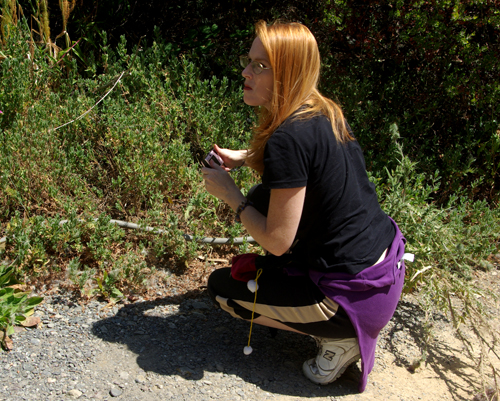
A family from the East Bay joined us and Louise took us on her butterfly rounds, initiating our tour with a very special treat–releasing an anise swallowtail she had protected as a caterpillar in a butterfly cage, who had just recently opened her wings. Gorgeous creature!
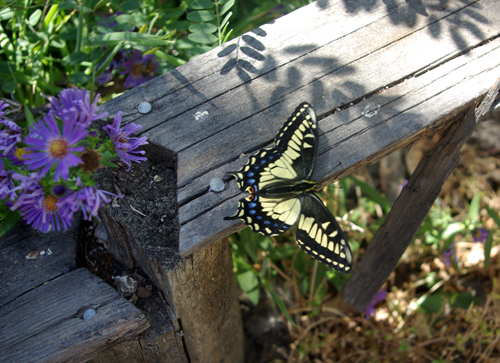
anise swallowtail
The anise swallowtail lays eggs on fennel. Those of you in the right locale might want to consider including fennel in your gardens to help ensure the survival of the anise swallowtail. Louise says they are on the decline. She attributes the decline of butterflies to loss of habitat, global warming and pesticides. She knows there could be other factors, but in her 92 years of contemplating her property, that’s her best assessment, folks. I take her word.
As we moved about the property I verified my original notes. Yes, the West Coast lady lays her eggs on wild mallow.
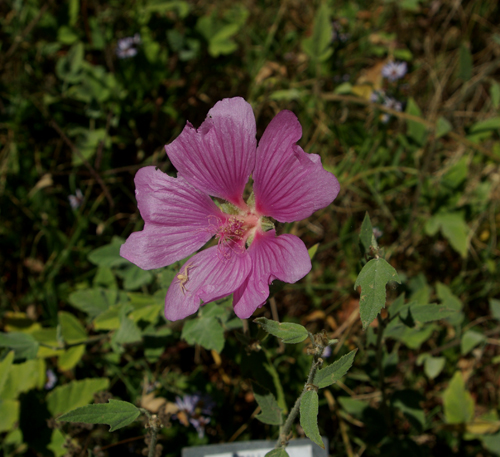
mallow with little companion spider
Western tiger swallowtails and mourning cloak butterflies both like willow for laying their eggs. The red admiral prefers stinging nettle. The humble plantain is home to the eggs of the buckeye butterfly. West Coast lady also likes hollyhock. I was relieved to hear this, as hollyhock lives in my garden in abundance. My guilt subsided when I heard this, as I have been integrating how lopsided my support of butterflies has been over the years. I need to add native plants, after carefully researching which ones are needed by which butterflies. I must do my part.
Now. The other half of the equation is so much easier, and probably most of us have been supporting the nectaring needs of butterflies for a long long time. Louise says they do, indeed, favor the butterfly bush and the salvias.

hot lip sage

blue sage
But here are others I found on her property you might want to consider including, if you have not already done so, and want to offer sweet food for butterflies who have emerged from their long journey of becoming.

aster
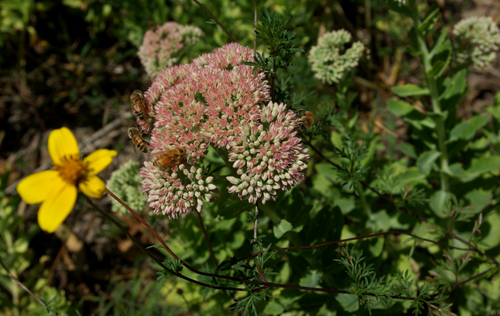
pink sedum
Louise says the bees adore the sedum, and, indeed, it seemed so.
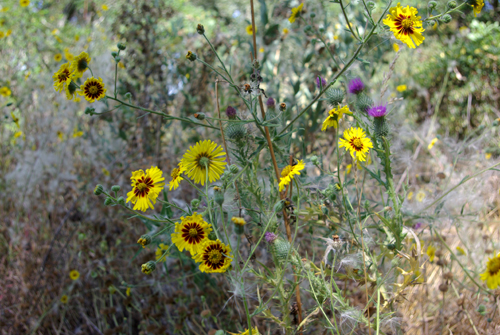
showy tarweed
“It’s sticky,” says Louise.
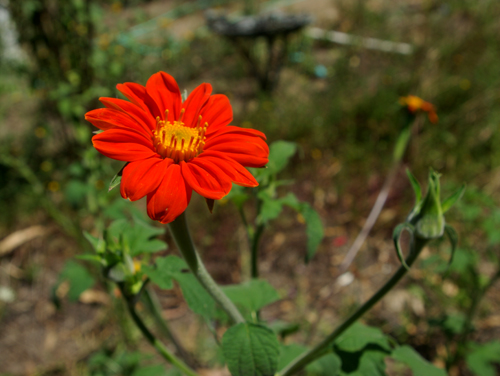
Mexican sunflower
Apparently the Mexican sunflower is a favorite of the monarch butterfly. I’d love to see that!

scabiosa
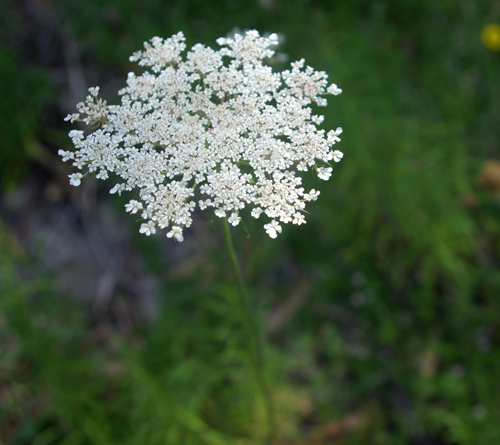
Queen Anne’s lace

milkweed
Note that milkweed can be a nectar food and a host plant. Monarch butterflies use them as host plants.
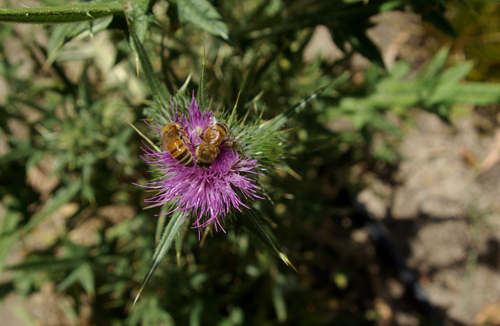
thistle
Thistle is a plant that the California dogface likes to nectar on, so we are hoping the ones Louise released last week will find these plants, feel at home, overwinter, and establish themselves next spring. Oh, may it be so!
Returning to the house I spotted this plant, thinking it was a butterfly bush, but Louise corrected me by telling me it was vitex.
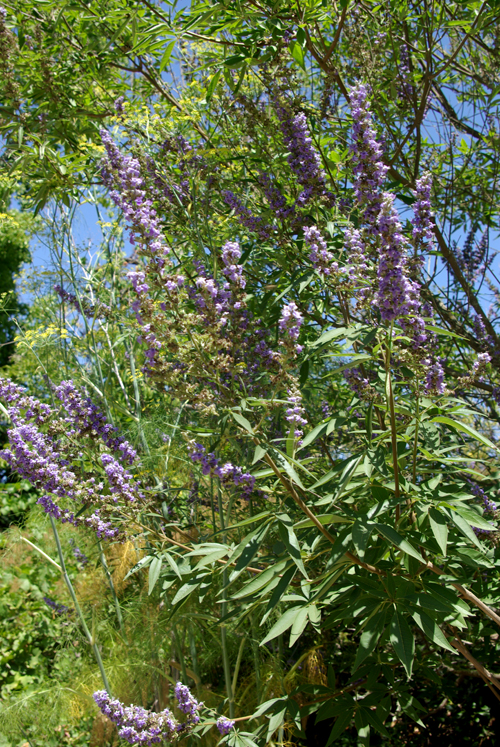
vitex
Here is what I’m hoping, dear readers. I’m hoping you will become inspired perhaps during the winter to make some time to discover what the native butterflies are in your locale, to find out what their host plants are, and to pick one or two, include these host plants in your garden and see if you can help ensure that your local butterflies get both the host plants they need for laying their eggs as well as the nectar plants I bet you have already established in your gardens. You might be surprised that one of the “weeds” you have been routinely pulling up is actually a host plant to some lovely butterfly, desperately needing it for her eggs. (Scary, huh?) Please do write to me and let me know. Please triple check your research. The more I learn the more I realize that many butterflies have an very narrow spectrum of host plants they can utilize in spite of sites touting that the butterfly can use dozens. Not so, says Louise. By adding your knowledge to the comments section, specifying your locale and what butterflies live there and what they need on BOTH ends, you really can contribute to the well being of one of the most beautiful of creatures we are blessed to share our planet Earth with. Thank you for your loving care and concern.
Love and caterpillar blessings!
Kathryn xoxoo
Footnote: Just heard from a fellow named Jeffrey Caldwell, a friend of Louise’s and he had posted a list of plants in CA that would attract mama butterflies here.
Posted on August 26th, 2009 by Kathryn
Filed under: Animals
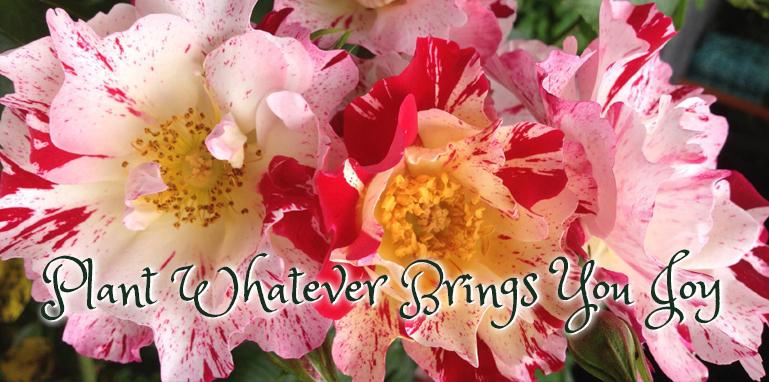
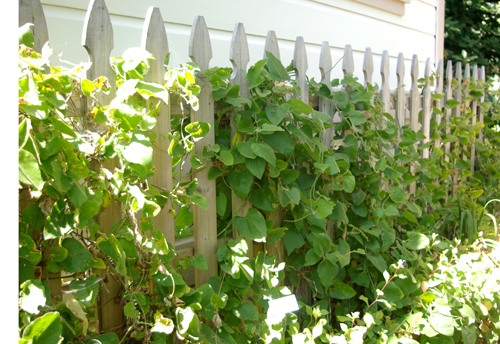

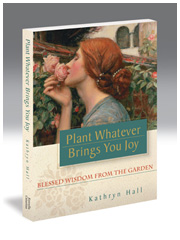







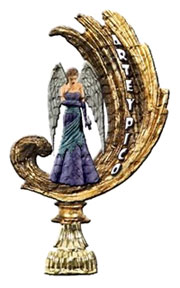

What a very special and important post, mom! Very Lovely!
Indeed the butterflies are a Wonderful gift and their nectaring & host plants need protection.
Thanks for bringing awareness here with such Beauty.
Love you,
Antonia
xoxox
Thanks, my dear. It was so fun to have you join me! I appreciate your indulging me and coming along and am delighted you immediately were inspired! Louise’s knowledge and enthusiasm are infectious! Love, Mom xoxo
Hi…I pop over and read your blog often and found this post to be, not only educational, but also much needed information in the propagation of the butterfly, so that she can be enjoyed for many generations to come. I live in Sonoma County and so, because we are on a large ranch, fight the star and purple thistle, always losing. You have made me feel good we do lose the fight!
I had never in all my years of gardening, thought about, or more importantly, been informed by nursery people, host plants for butterflies nor even knew they differed from the nectar plants. I actually “assumed” they were both the same, for some inane reason… and yes, I do have plenty in the nectar plants in my gardens but probably nothing I have planted unless my mallow, [the lowly bush type which I believe to be a native], for the host plants. I just had no idea!!
Thanks so much for writing this post. If I may, I shall create a link and write a post about this myself for my readers who garden too!
happy gardening~~
Hi, Linda! Yes, isn’t it utterly astounding that we generally don’t know this? I was dumbfounded! And I bet you are not alone in fighting off some plant or other that the poor butterflies are needing! It’s just amazing. Yay, for your thistle! And I would be really appreciative of the link and post. We need to spread the word! Thank you! Kathryn xoxo
I’ve carefully been planting nectar producing plants in my butterfly garden for the last couple of years. I actually was aware that there are nectar plants and host plants but didn’t give it much thought until this post. I happen to have a print out for Northern California from http://www.localbirds.com that specifies caterpillar food plants (I’m thinking that’s “host”) and butterfly nectar plants. Here’s what its got down for the host ones (a number of them you also mention):
Clovers
Violets
Buckwheats
Common California Aster
Pearly Everlasting
Grasses (Bunch & Carex)
Deerweed
Snapdragon
Mallows (whew, we’ve got one of these!)
Plantain
Nettles
Field mustard
Thistles
Wild radish
Monkeyflower (got one of these too!)
lupines
Duthcman’s pipe
California coffeeberry
Milkweed
California buckeye
Fennel
Willows
Ceanothus
Oaks
I’ll have to think about adding a few more to the garden next year.
Hi, Green Bean! Good morning. See? Isn’t it amazing we have this hole in our educations? Yes, caterpillar food would be a host plant. They are also called larvae plants (as if we needed this to be more obscure, right?) 🙂 Thanks for that list. It’s a start. I think it’s important for us to ID the butterflies for our specific areas, as certain butterflies are found in one part of a county, not in another part of a county, and then add those host plants to our gardens. I don’t think buckshot will work. For example if there are a lot of oaks it’s more likely you will have CA sister butterflies, but not necessarily. If we are going to do this right we have to be more scientific and do the research and find out what will work for our micro climate or micro environment. Remember these eco-systems (which we have messed up through building) were developed over literally thousands of years. When some butterfly selected, say, nettles, it’s because nettles was in abundance and prevalent in an area. So they adapted to that. Etc. It’s complex. The more we share, the more we can do. I hope you will consider writing about this on your blog. Thanks! Kathryn xoxo
I captured a photo of a Monarch on Tithonia, Mexican Sunflower, just yesterday, among a swarm of Gulf Fritillaries and dark Swallowtails.
Tiger Swallowtails seek out Wild Cherry trees in my south GA garden, not necessarily in other places. It takes much research to know who visits and what they prefer.
An important point to know is what seasonal flowers different butterflies visit for nectar. We have butterflies almost year around here, and nectar plants differ in different months.
I’ve posted several butterflies on my blog the past few days, if you care to visit. The Label Cloud at the end will lead you to more.
Hi, Nell Jean, I did, indeed, visit your blog and your butterfly photos are beautiful. How wonderful to find the monarch. And, yes, I would agree, that it takes a bit of research to find out the exact needs throughout the year for each kind of butterfly. It’s a small price to pay, isn’t it? How fortunate that you have butterflies all year long in GA, and thank you for pointing out that different plants provide nectar at varying times of the year. Lovely. Kathryn xoxo
That is a lot of good information. I never really thought about the host plants. I kept a few around. I think next season, I might try and get some more host plants and see if I can attract more butterflies.
Good morning, Element! That would be great! I look forward to hearing of your success. I hope you do talk to your local entomologists (closest university?) and see if they can guide you as to what would work best to help ensure you get those butterflies and help them out! Thanks! Kathryn xoxo
Hi Kathryn!
These are all my favorite plants! I have most of these in my garden, except the tarweed, which reminds me to purchase a packet from Larner seeds in Bolinas. Do you know them?
We love butterflies, and everyone comments on how many there in our city garden on a hill. I planted (I had to take a break from writing this as Isis, our Siamese, decided she wanted to gently bite my wrist and forearm! Pay attention to me, she says) I planted quite a bit of milkweed this year. I combined it with tall violet flowering Verbena bonariensis and a bit of white flowering sage. I love how butterflies are attracted, and have been playing with color combinations. The orange flowers of Asclepias and Tithonia are dramatic with their color complements in purple and violet. The effect is a bit vivid, so the bit of white flowers and silver foliage ties it together for me. I love how one can play with these plants aesthetically and provide for butterflys, too. I love having it all!
I love the pipeweed vine. Plants like these such a gourd vines, grape vines, sweet peas and four o’clocks create such a nostalgic air and a haven for all.
Thanks for sharing the information and enchantment!
🙂
Philip
Hi, Philip! Wow! How impressive that you have all these plants in your garden already! You could teach a Butterfly Class! 🙂 And it sounds like it’s very much working, not just pragmatically but aesthetically! I look forward to seeing photos on your blog sometime of these plants, helping to spread the word! 🙂 A haven for all. Love that. 🙂 Don’t know Larner’s. Will check it out. Thanks for the visit! Kathryn xoxo
What an excellent informative post! I will have to try to garden even more in tune with butterflies with this information 🙂 We really have to be mindful of supporting such wildlife. There are so many fewer butterflies in the past few years… I think the farmers crop dusting in this area has been a real hazard for them.
Good morning, Ilona! Thank you so much! We do, indeed, need to be mindful of the wildlife, especially as it’s us making it so hard for them to survive. So glad you are mindful! Kathryn xoxo
Thanks – I didn’t know the difference either. Gorgeous shots of butterflies! We get a lot of Monarchs in early fall around here as they start the migration. I love how they eat milkweed to make themselves toxic to birds. I enjoy the wildflowers in our yard and the occasional butterfly does too.
Hi, Sarah, Thank you! I felt so privileged to have captured them! Lucky you to have monarchs about, and thanks for reminding me about eating milkweed to discourage the birds. It’s fortunate you have wildflowers, really enhancing the likelihood of spotting the lovely butterflies passing through. Kathryn xoox
Kathryn,
Such a great post, I was only thinking that I must research the plants that bring the butterflies into the garden here in the UK – as my garden only seems to have cabbage whites. So now I shall take that one step further and see what the caterpillars like to eat.
K
Good morning, Karen! You have utterly cut to the chase. That’s the bottom line question. What do caterpillars like to eat? Can you imagine nurseries inviting us to ask that question? And then fulfilling the answer? No. We must do it ourselves AND spread the word! I’m endeared that you also have an abundance of cabbage whites in your garden. So do we! So hard to capture on camera, aren’t they?
Thanks for the illuminating comment, Karen. Kathryn xoxo
Karen in the UK will find the Post Code Plants Database quite useful:
http://www.nhm.ac.uk/nature-online/life/plants-fungi/postcode-plants/
In Australia, go here:
http://www.floraforfauna.com.au/
In California’s San Francisco Bay Area, I wrote a little booklet years ago, available from Larner Seeds
http://www.larnerseeds.com/_pages/books.html
on their Books page lookat the bottom of their “Notes on Natives” booklet series for: “Notes on Larval Food Plants of Some Bay Area Butterflies”. It lists native plants serving as larval hosts for some of the commoner butterflies. I hope to come out with updated efforts soon.
The pipevine swallowail in the eastern United States expanded its range about 1000 miles to the west by colonizing its host plant being cultivated in gardens.
According to the booklet “Desert Butterfly Gardening” by the Arizona Native Plant Society/Sonoran Arthropod Studies Institute, cultivation of a larval food plant of the Large Orange Sulphur, namely the Feather Tree (Lysiloma microphylla), has resulted in the butterfly being seen much more often in urban situations. On the other hand, they note that a groundcover plant, Frogfruit, Phyla nodiflora, was formerly more cultivated to the benefit of the Phaon Crescent — which has now largely disappeared from desert urban areas because usage of the plant has gone out of style.
Some few enlightened gardeners are growing plots of larval host plants, as one would grow a vegetable garden for people, but for butterflies. Even sprinkling a few larval plants here and there in the landscape can be very helpful.
I am working on the theme of garden design with butterflies in mind.
best regards,
Jeffrey Caldwell
Hi, Jeffrey! And here you are! It’s very kind of you to provide so much additional information. Readers will be grateful, I am certain, as am I. I have in mind an area of my garden currently hiding in ivy, that I intend to pull up and replace with some of the plants you suggest. Then I will pray they find them. Thanks for mentioning the booklet at Larner Seeds, the second time Larner is here mentioned. Must avail myself. Kathryn xoxo
Hi Kathryn, lovely photos and good information especially about learning which butterflies are in a particular area. Butterflies also like their gardens a bit messy so that they have cover for those precious eggs. Thanks for taking us along with you and Antonia. It was fun.~~Dee
Hi, Dee! Love seeing you here! Messy is good. It’s a boon to any of that have corners we thought we should be clearing up, when all along they were the perfect safe harbors for butterflies! Thanks for the visit! Kathryn xoxo
[…] Butterfly Gardens: Host Plants vs. Nectar Plants Share this on del.icio.usDigg this!Share this on RedditStumble upon something good? Share it on StumbleUponShare this on TechnoratiShare this on FacebookTweet This!Subscribe to the comments for this post?Share this on Linkedin August 28th, 2009 | Category: Butterfly Garden, Gardeb Articles | One comment […]
Thank you, kind Sir! 🙂 Kathryn xoxo
Ah Kathryn, as ever, a beautiful written and highly informative post. I had never stopped to consider the host plant bit – I’d just accepted with joy all the butterflies in the garden. I’m going to start working on it now, so thanks for that! 🙂
Oh, and by the way ……. I’ve nominated you for the meme on ‘seven things you didn’t know about me’. I hope you don’t mind! There’s no pressure to do it, but if you want to take part, then the rules are over on my blog!!! (it’s your own fault for having such a great blog!)
Excellent post!
Hi, Liz, you honor me with your invitation, and, alas, I do not participate in memes. So sorry. Nothing personal, just a decision made years ago. I’m so glad you love the post. I do hope it’s reached far and wide and will make just a teeny difference in the life of some butterflies. i do believe it will! Thank you for considering them and their needs. Big hug and thank you again for your very kind words. It means a lot. Kathryn xoxoo
Good morning, Barbee! Thank you so much for your visit! I did pop over to your blog! Kathryn xoox
I am totally inspired! Earlier this spring I was forming the idea that I wanted a butterfly garden, and now i have the fuel to do it! Thanks!
Red Clover–See? This one we can do with just a bit of research and it moves us more towards being PART of the natural grid. I’m learning how to talk about this and it’s exciting. I find myself thinking of the environment as a piece of fabric, which we’ve cut up. How do we weave it back together and thus rejoin the natural system with all that entails? That’s the challenge! 🙂 Kathryn xoox
Hi Kathryn, I have client here in the northeast and they have a Dutchman pipe (Aristolochia and it has a problem with the leave curling and spotted. These spots are raised around the outer edges.it is not an insect so I expect it is a fungus. I cannot find these symptoms in any book. Have any idea? Thanks Carl
Hi, Carl, So sorry. Not a clue. Have you checked with local ag offices? Kathryn xoox